Making this Alfajores Recipe is fun and creative. Alfajores are dulce de leche-stuffed shortbread cookies coated with shredded coconut. They are usually served at tea time in Argentina, but they can also be a snack or dessert.
Want more South American recipes? Then try our Chicken Empanadas Recipe, Brazilian Chicken Salad or a Peruvian Seafood Soup.

The recipe is simple to achieve, and the result is these mouthwatering Argentinean alfajores, of which you never have enough.
Why I Love This Recipe
- Fun to try another country’s exceptional recipes
- Not too sweet but totally satisfying
- Filled with luscious dulce de leche
- Pretty cookie to add for the holidays or anytime
- Unique and different
Helpful Items for This Recipe
This post contains affiliate links. As an Amazon Associate, I earn a small portion from qualifying purchases at no extra charge to you.
Dulce de Leche Repostero Confectioner’s Thicker Milk Confiture for Bakeries, Cakes and Pastry

Ingredients You Need for Alfajores
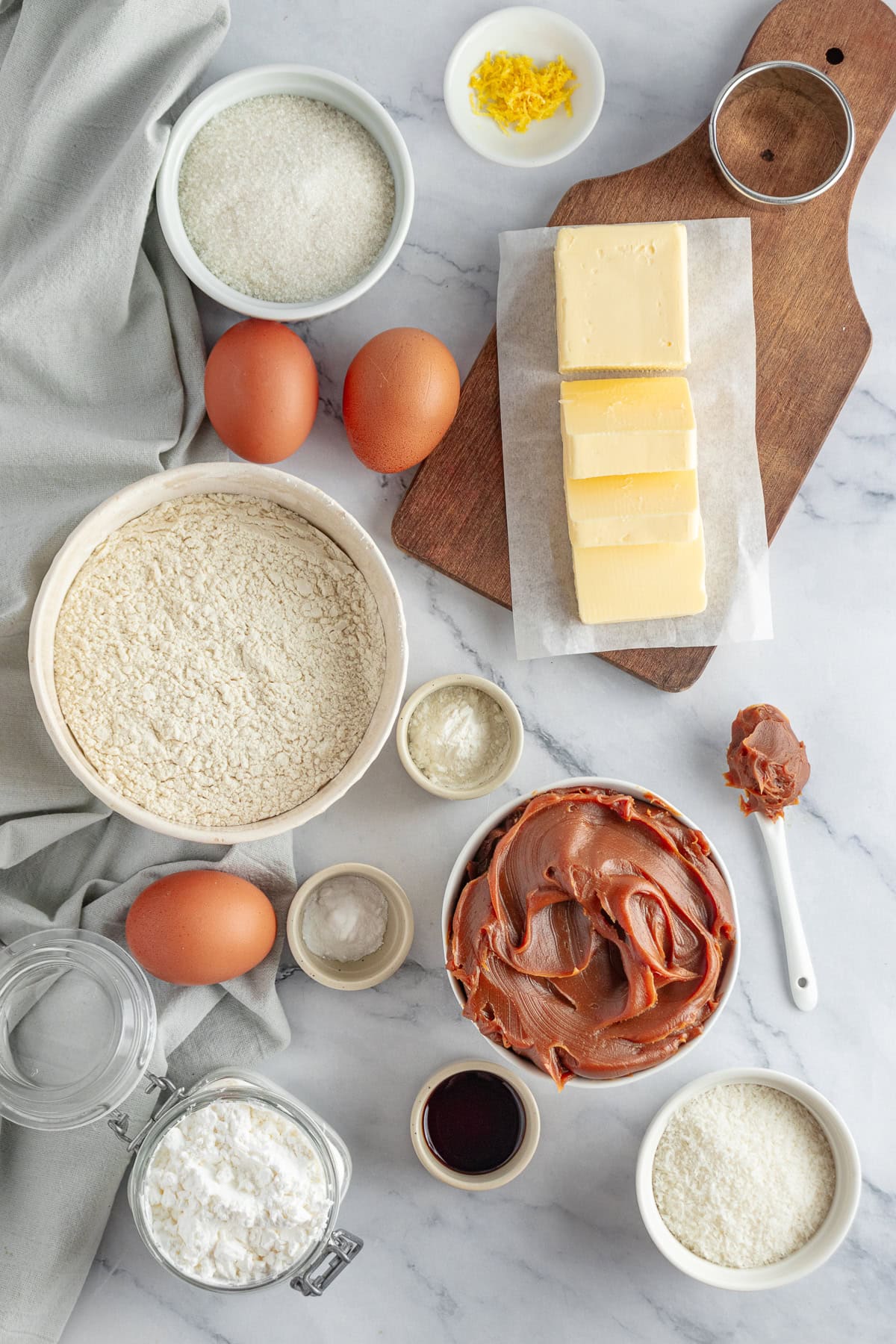
They are a shortbread-like cookie that is a bit softer than traditional shortbread, and sandwiched in the middle is a thickened dulce de leche.
Recipe Ingredients
All-purpose flour – Alfajores are made using a combination of flour and cornstarch; it’s important to use both to achieve the melt-in-mouth texture of the cookies.
Cornstarch – Make sure to use cornstarch and not cornflour for this recipe.
Baking soda and baking powder – These are needed to make a puffy and flaky cookie.
Unsalted butter – Like any shortbread cookie, you’ll need a good amount of butter to make them.
Granulated sugar – Different recipes vary from granulated to powdered sugar. This one uses granulated sugar, and it is NOT possible to replace it in equal amounts with powdered sugar.
Egg yolks – They add color and extra fat to the alfajores, enhancing flavor and texture.
Vanilla extract – To flavor the cookies. Always use the highest quality available.
Lemon Zest – The traditional recipe uses a hint of lemon zest to add freshness to contrast the sweetness of dulce de leche. Though I love adding it, it’s an optional addition.
Dulce de leche repostero – It’s key for this recipe to use thick dulce de leche AKA repostero or pastelero. The classic version is runnier and causes alfajores to fall apart, making your filling messy. There are links supplied above for both of these dulce de leche!
Thinly shredded coconut – Coating the alfajores with coconut is traditional in Argentina; it provides a characteristic flavor and also helps to dry the sides of the alfajores, making them easier to handle and store.
How to make the best alfajores cookies



Preheat the oven to 325°F (160°C) and line two baking sheets with parchment paper.
Sift the cornstarch, flour, baking soda, and baking powder together in a bowl.
In a bowl, beat the butter and sugar together. Add the egg yolks one at a time, mixing well after each addition.

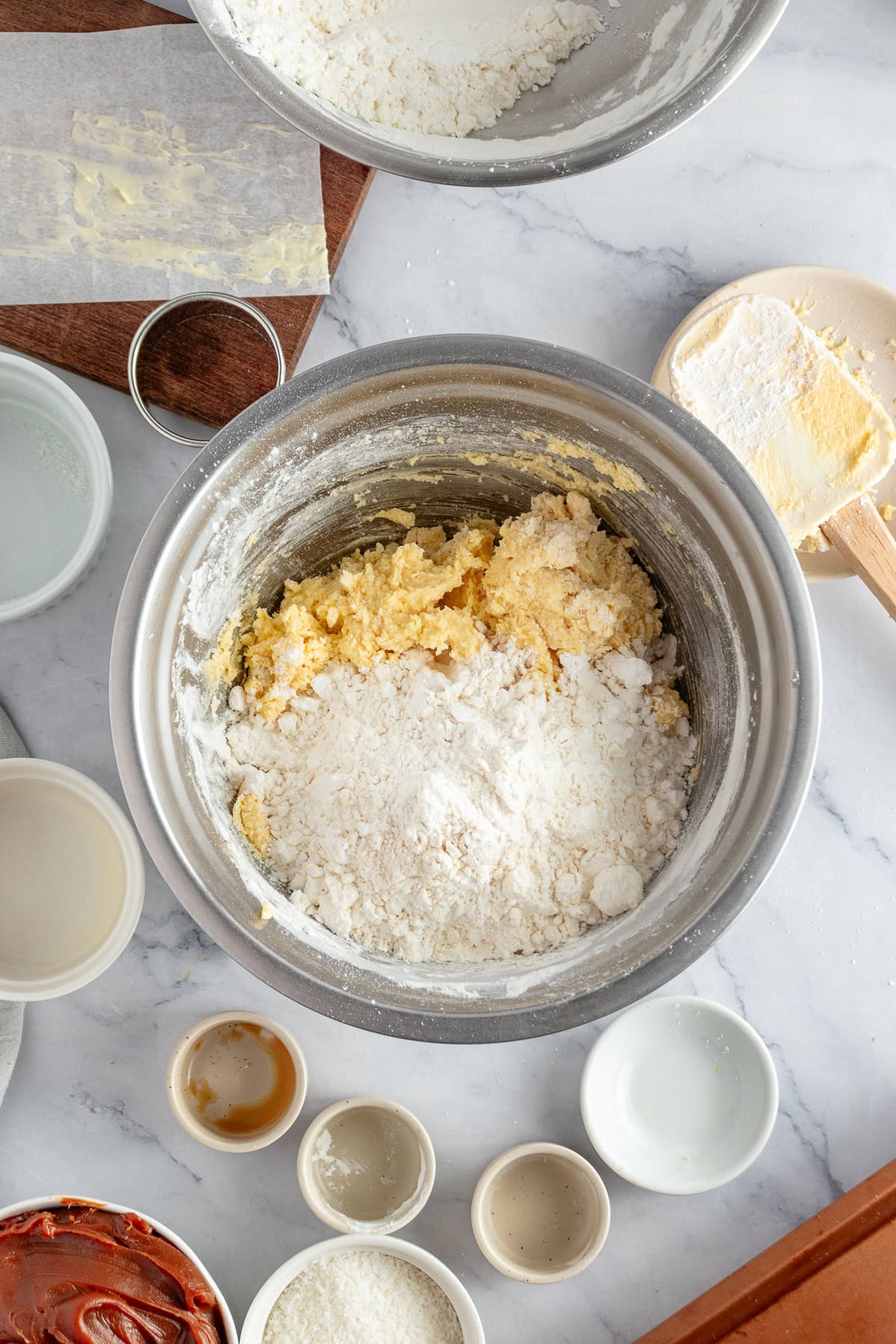

Add the vanilla extract and lemon zest to the bowl and mix well. Then, incorporate the sifted dry ingredients.



Roll out the dough on a floured surface until it is about 1/4 inch thick. Cut into circles using a round cookie cutter.
Place the circles on a clean baking sheet slightly greased with butter and bake in a moderate oven for 15 minutes. Once the cookies are baked, let them cool completely.



Assemble the alfajores by sandwiching two cookies together with plenty of dulce de leche in the middle.


Finally, place the shredded coconut in a small bowl and roll the sides of the alfajores in it, covering the dulce de leche with coconut.

Tips for making the best alfajores
1. Use cornstarch for a soft, crumbly texture: Cornstarch is the secret ingredient in traditional alfajores. It makes the cookies light, tender, and almost melt-in-your-mouth. Don’t skip it!
2. Chill the dough before rolling: The dough can be sticky and delicate, so chilling it for at least 30 minutes makes it easier to roll and cut without losing its shape. This is recommended on hot days and is not needed all year round.
3. Roll the dough evenly: Aim for a consistent thickness of about 1/4 inch (0.5 cm). This helps the cookies bake evenly and ensures a nice balance between the cookie and dulce de leche layers.
4. Don’t overbake: The cookies should remain pale with just a hint of golden color on the edges. Overbaking will make them dry and lose their signature softness.
5. Choose high-quality dulce de leche: The filling is the star of the show, so go for a rich, thick dulce de leche. Argentine brands like La Serenísima, San Ignacio, Vacalin, or Havanna are ideal if you can find them, but any thick caramel spread will work.
6. Assemble carefully: Use a piping bag or a spoon to spread an even layer of dulce de leche, making sure it’s not too thick so it doesn’t spill out. Gently press the cookies together to avoid breaking them.
7. Don’t skip the coconut: Rolling the edges in shredded coconut not only gives the alfajores their signature look but also adds a subtle flavor that ties everything together.
8. Let them rest before serving: Once assembled, let the alfajores sit for a few hours (or overnight if you can wait). This allows the dulce de leche to soften the cookies slightly for that perfect bite.
9. Store them properly: Keep alfajores in an airtight container at room temperature for up to a week, or refrigerate them for a slightly firmer texture.
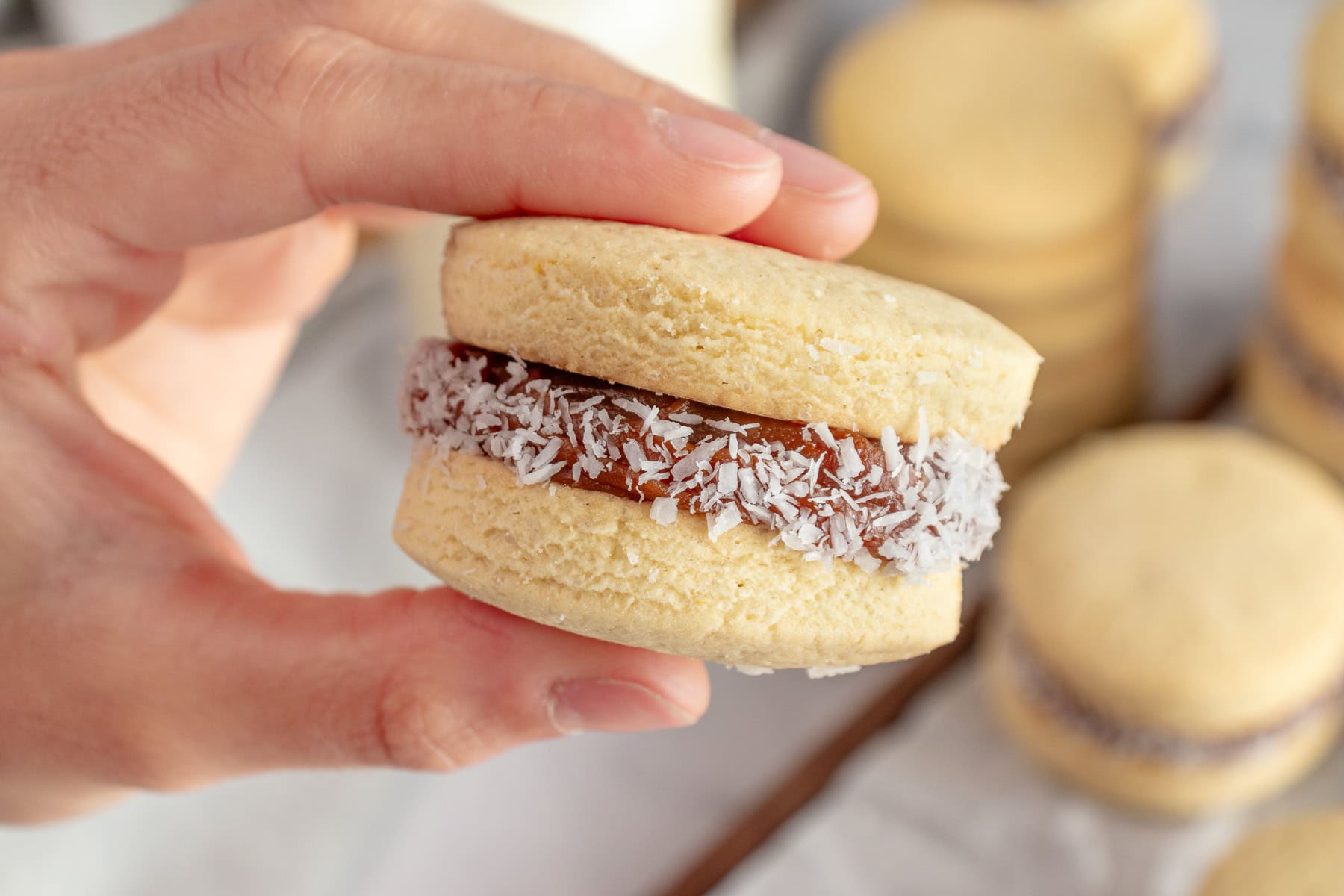
Recipe Pro Tips!

What are Alfajores?
Alfajores are a classic treat in Argentina and many parts of Latin America, and they’re as simple as they are satisfying. These soft sandwich cookies are sandwiched with a generous layer of dulce de leche and finished with a roll in shredded coconut for a little extra texture and flavor.
What makes alfajores so special is their balance. The cookies are tender without being overly sweet, which pairs perfectly with the rich, caramel-like dulce de leche. They’re a go-to snack with coffee or tea and a staple at celebrations, but they’re just as good for an everyday treat.
Whether you stick with the traditional recipe or experiment with variations like chocolate-coated versions, alfajores are the kind of dessert that never disappoints. Once you try them, they might just become one of your favorites, too.
How long do alfajores last?
Alfajores can last up to 1 week when stored properly in an airtight container at room temperature. If you live in a warm or humid environment, it’s best to keep them in the refrigerator to maintain their freshness; this can extend their shelf life to about 2 weeks, although the cookies might firm up slightly in the fridge.
can I freeze alfajores?
For longer storage, you can freeze alfajores. Place them in an airtight container or freezer-safe bag, separating layers with parchment paper to prevent sticking. They’ll keep well in the freezer for up to 3 months. When you’re ready to enjoy them, let them thaw at room temperature for the best texture.

WOULD YOU LIKE MORE GREAT COOKIE IDEAS?
We love making cookies and are always on the search for unique ones. Here are some of our favorite!

Alfajores Recipe
Ingredients
- 1 1/2 cup all-purpose flour
- 2 1/4 cup cornstarch
- 1/2 tsp baking soda
- 2 tsp baking powder
- 7 oz unsalted butter
- 3/4 cup granulated sugar
- 3 egg yolks
- 1 tsp lemon zest
- 1 tbsp vanilla extract
- 2 cups dulce de leche repostero thick dulce de leche
- 1/2 cup finely shredded coconut
Instructions
- Preheat the oven to 325°F (160°C) and line two baking sheets with parchment paper.
- Sift the cornstarch, flour, baking soda, and baking powder together in a bowl.
- In another bowl, beat the butter and sugar together. Add the egg yolks one at a time, mixing well after each addition. Add the vanilla extract and lemon zest to the bowl and mix well. Then, incorporate the sifted dry ingredients.
- Roll out the dough on a floured surface until it is about 1/4 inch thick. Cut into circles using a round 2'' cookie cutter.
- Place the circles on a clean baking sheet slightly greased with butter and bake in a moderate oven for 15 minutes. Once the cookies are baked, let them cool completely.
- Assemble the alfajores by sandwiching two cookies together with plenty of dulce de leche in the middle.
- Finally, place the shredded coconut in a small bowl and roll the sides of the alfajores, covering the dulce de leche with coconut.


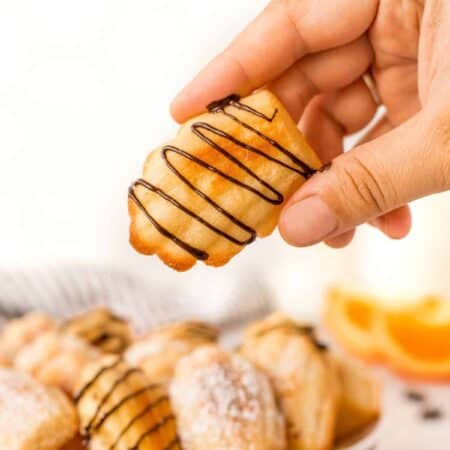
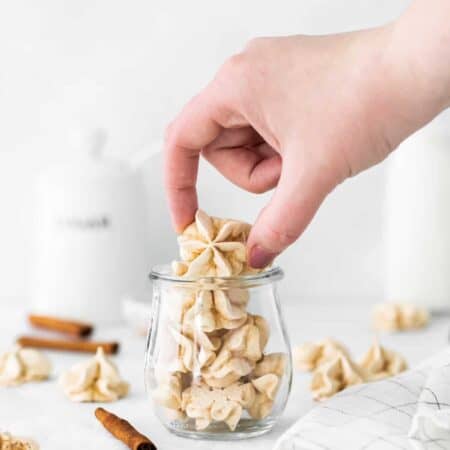












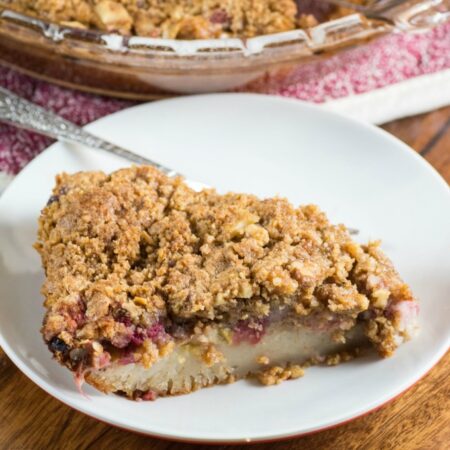
Let us know what you think!
We’d love to know what you and your family think! Make sure to leave a review below and follow us on your favorite social network!